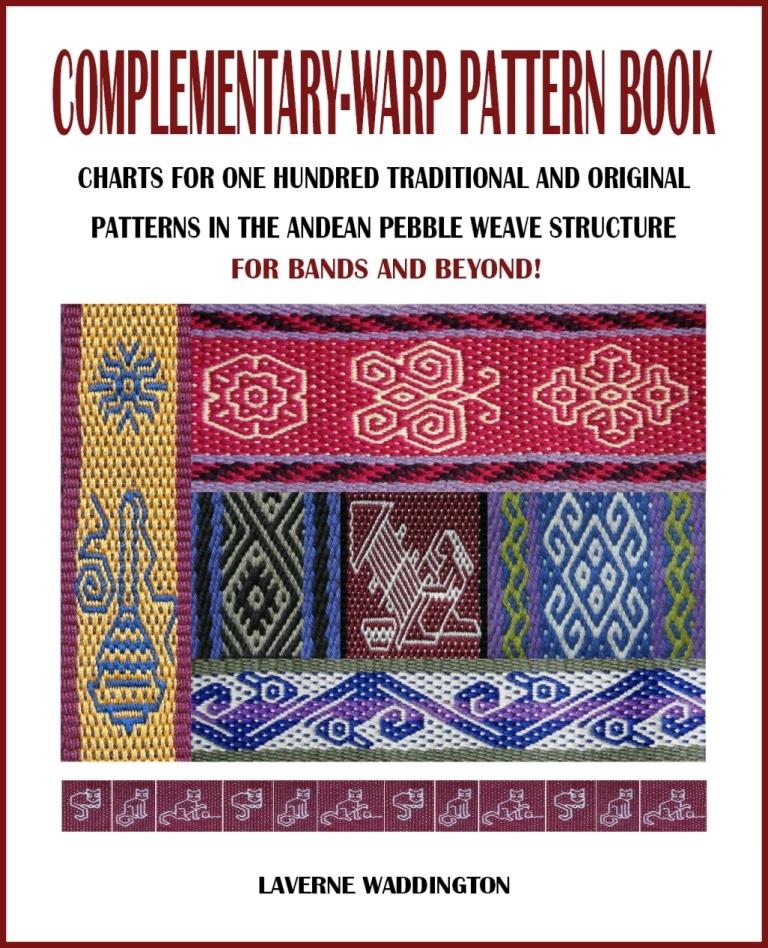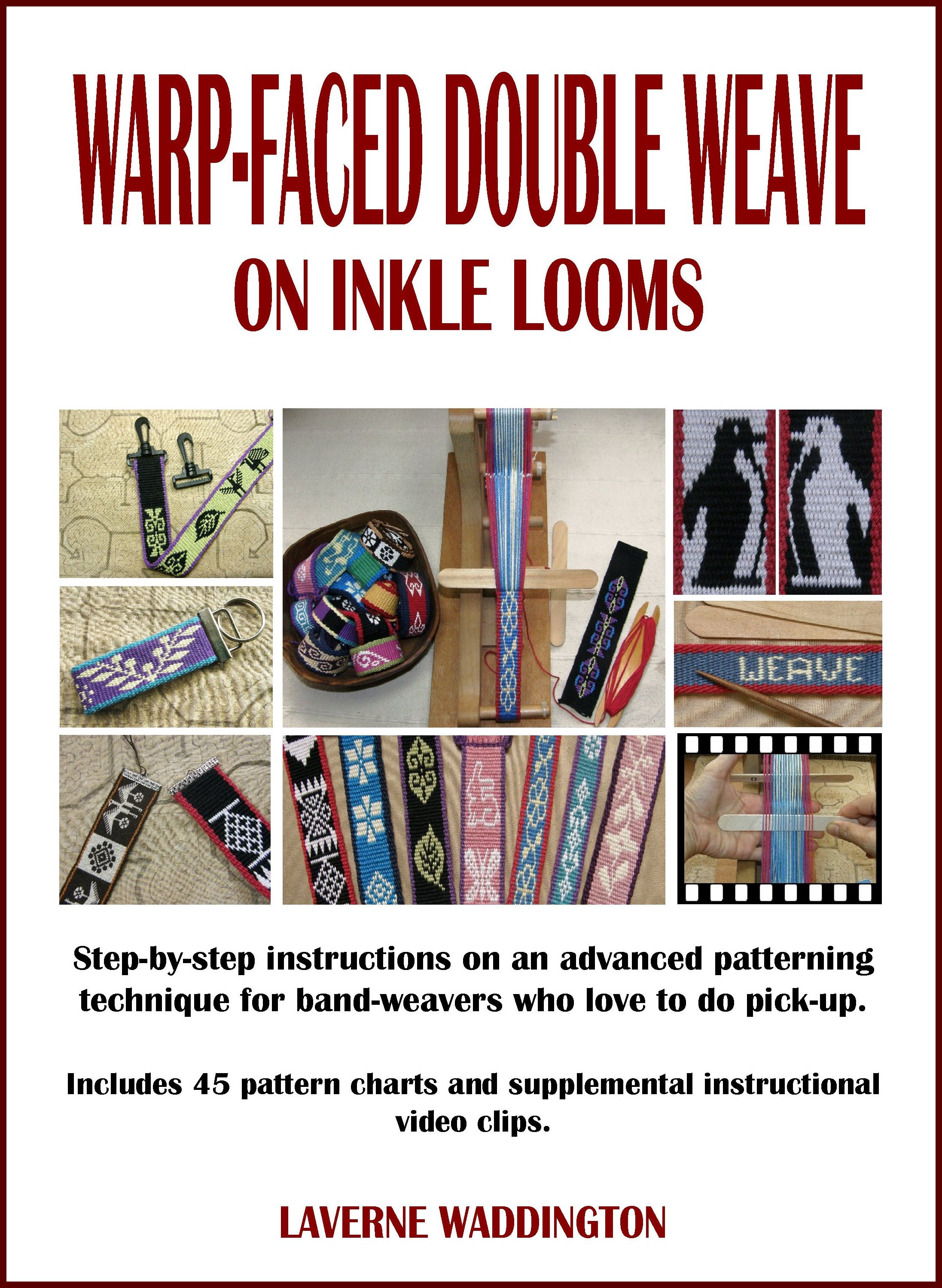In my last post, I showed you what happens when I become way too immersed in the process and forget about the product. I ended up with a new strap for my camera in the lovely reversible three-color pebble weave on which the hummingbirds were upside down on one end! Friends told me that this was done on purpose so that I could see them the right way up when I looked down. I have some very nice friends :-).
I am trying to think of a time when the reverse was true and product may have overtaken my thoughts about process. I guess there was this example where I needed a wool band fast-fast for a work shop I was teaching in which way more people signed up than expected. I forgot all about my backstrap loom and jumped onto my friend Pam’s floor loom. Pam offered to set up the loom. After all, she would do it far more quickly than I would have been able to given my limited experience. Then I took over to weave.
In my latest project, I find myself slipping back into process mode. I guess my focus is on designing and structure for this one as I am using a structure that I don’t often use….Finnweave. The product? I’ll make one up along the way.
I didn’t learn this one from any of my indigenous weaving teachers. That and the fact that I seldom use this structure, had me pulling out my notes to remember how it all works. Learning it from a teacher in Mexico, for example, where it is still practiced, would have involved days, if not weeks of study. Prior to that, there would have been days spent looking for teachers, more days spent waiting for them to discuss with family and/or friends the price they should charge, time spent preparing yarn if there wasn’t any on hand, and possibly even more time spent scratching about for loom parts which were perhaps long since out of use and maybe even re-purposed. One of my teachers in the highlands was using one of her warping beams as a fence rail.
And then there would be the days or weeks of interaction with my teacher as I watched and tried to imitate her movements at the loom. I can only describe some of my earlier learning experiences as a real struggle when no verbal explanations were being given or patterns provided on paper. Of course, there is more than one way to impart knowledge and skills and I learned to adapt. All that combines to implant some pretty firm memories which make it much easier to just pick-up a technique that I haven’t used in a long time and slip easily back into it. Obviously it’s not the same as learning something from a book.
It annoys me having to study a structure all over again! Why won’t it sink in and stay there?! In the process I improve my notes so that it will be easier and quicker the next time. And yes, it does get faster each time. My notes include tips that I have come up with myself for remembering, for example, the home position of the two shuttles, which color comes next, and the changes I make to the basic loom set-up depending on whether I am weaving a narrow or wide piece. These are things about which I need to be reminded when I first get back into it.

This time I am using 20/2 wool for the first time in Finnweave. I needed to sample again for a width gauge and to see if the proportions of my motifs in this material matched those of the figures on my old charts.

Those figures are adapted from a crochet pattern by Svetlana Rogatykh (she does amazing work in crochet!). This is a smaller version that I drew of the much larger one I showed earlier. The larger one is much closer to Svetlana’s creation for crochet.
I had decided that I wanted to weave a foliage pattern and set about creating leaf patterns….my usual thing…basic oval-like shapes with veins. They were all too large and also difficult to position at different angles. I wanted something more delicate that would climb and twist its way up the warp and not something static and repetitive. This structure allows horizontal and vertical lines. Diagonals are harshly stepped. I was about to give up until I decided to look at Svetlana’s work again. She offers a free foliage pattern and that gave me the spark that I needed to get this going. Her leaves are also in horizontal and vertical lines and in all kinds of hard blocky shapes that alone would not be recognizable as leaves at all. However, place them all on a stem and make them all just a little bit different, and suddenly you have a lovely pattern of flowing foliage, somewhat delicate despite the hard stepped diagonals and block-like shapes…..at least to my eye.
So, I had to create another sampling warp.
I would have loved to have designed some hummingbirds but that just wasn’t going to work. I went for tiny butterflies instead…simple enough, just two triangles. I was thinking that if I swapped those butterflies for fish, this could also make a nice aquatic scene.
This second sample gave me another opportunity to test the proportions of my woven figures against my charted ones and confirm the width information that the first sample had provided. I added my large leaves to compare….nope, they really are too big.
Then it was onward to the real project. The samples finished off my supply of black 20/2 wool but there is still a lot of green…perfect.

I took a lot of time at the start settling the threads and trying to make sure that the spacing between the warp threads is as consistent as possible across the eight inches of warp. I find it handy to be able to divide the warp in half and then in quarters with my lashing cable ties. I count out the threads to make sure that I place the ties in the right places. I can then focus on one section at a time making sure that each half measures four inches and each smaller section two. I check that the threads are as evenly spaced as possible within those sections.
Maintaining that sett without a reed is much easier for me to do in this double-weave structure as opposed to plain weave. Something about the exchange of colors between the two layers of the double weave seems to help. As soon as I stop weaving patterns and the layers separate, I risk losing control of the sett.
Of the course, the last ten or so edge warp-ends are the ones that most want to snuggle together and hide the weft. I don’t usually weave patterns all the way to the very edge and so those warp threads are left free to misbehave. I was watching a weaver in Mexico weaving plain balanced weave on her backstrap loom in a video and noticed that after every four weft shots or so, she would take a pointed stick from where it had been parked in her hair and strum the warp threads in the last inch at the selvedges. She would strum outward. I figure that she must be coaxing those problem threads apart. I must remember to do that too.
I feel like I have been neglecting my loom’s role in this whole process. I seem to be taking my beloved backstrap loom for granted and I think that I will devote my next post to more about the loom and how it works in my hands. I guess I just see it more and more as a part of my body when I am weaving in the same way that I used to feel that skis were just an extension of my feet!
Until next time.





























I just love seeing your creative process. I love all the trials that you weave as I have never been one for sampling. I like the way the leaves came out, it should work great! Have fun:-)
Theresa
By: tscweaves on June 24, 2022
at 1:27 am
Thanks, Theresa. I can’t wait to finish one whole “branch” as right now, the little I have woven looks like a chaotic collection of lines that makes no sense at all!
By: lavernewaddington on June 24, 2022
at 1:31 am
I would love a book / video series on how to do Finnweave! Or maybe a list of online resources for learning it. Thank you in advance for any help you are able to provide!
By: Sharon Peterson on June 24, 2022
at 1:41 am
Hi Sharon. I don’t know about online resources for learning. I learned it from the book Double Woven Treasures of Old Peru as well as an old issue of the Prairie Wool Companion by David Xenakis. If you already know how to do some form of double weave pick-up, the article by Doramay Keasbey in Handwoven magazine’s Jan/Feb 2011 issue might be enough to lead you into Finnweave. Note that it is the least reversible of the various double weave pick-up structures (although it gives the cleanest image in the upper face). I have chosen it because it used to be practiced in old Peru and I have some pre-columbian textile fragments in this structure. Jennifer Moore’s book is a great doubleweave resource although it doesn’t cover Finnweave.
By: lavernewaddington on June 24, 2022
at 1:54 am
Astonishing work Laverne. Love the colibrí. I am glad someone as experienced as you also has the upside down brain glitch every so often.It happens to me when I weave tapestry from the back and forget to flip my cartoon…. hugs K
By: fiberassociations on June 24, 2022
at 1:51 am
Thanks, Kate. Ooh, I feel your pain!
By: lavernewaddington on June 24, 2022
at 2:04 am